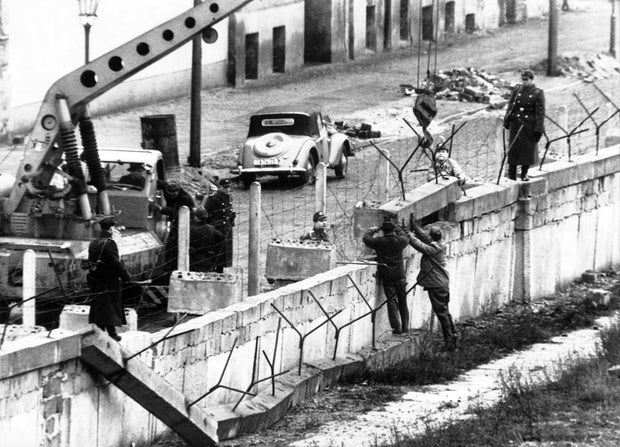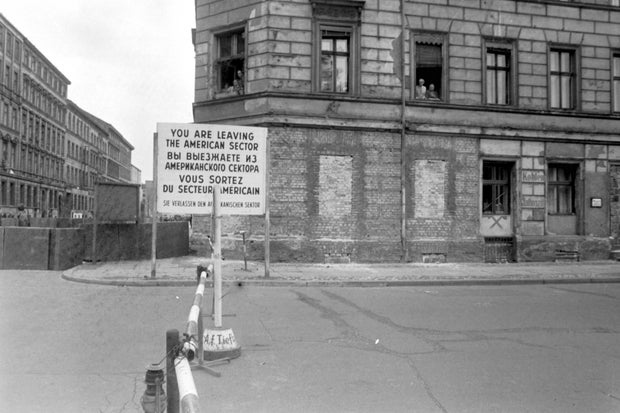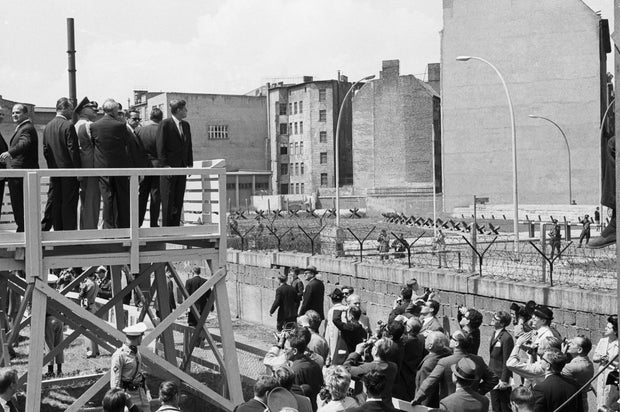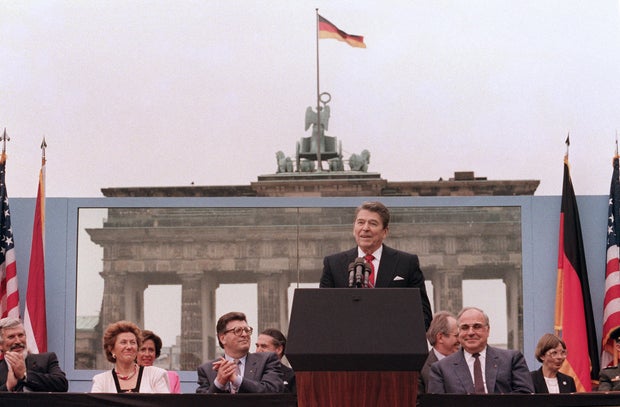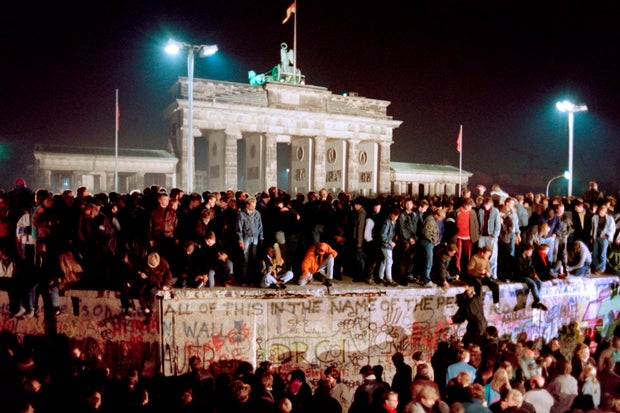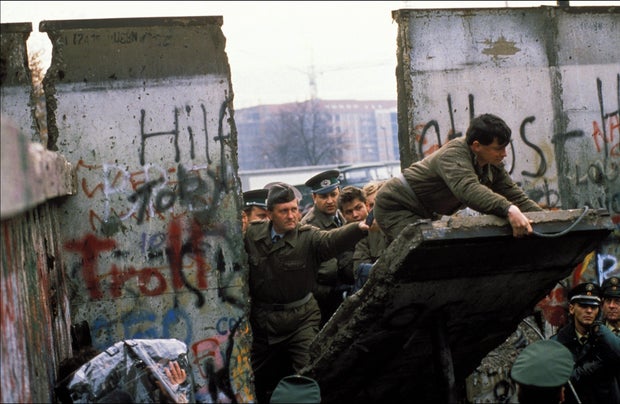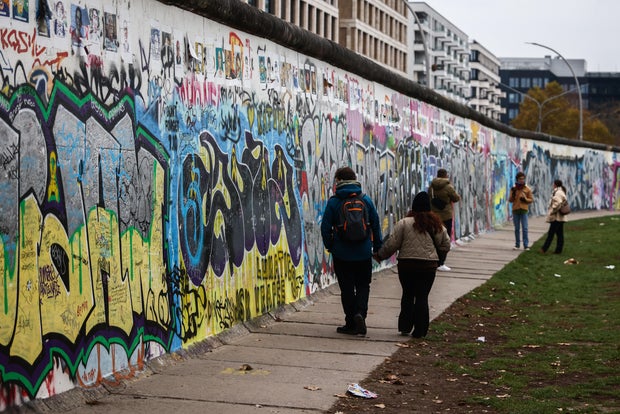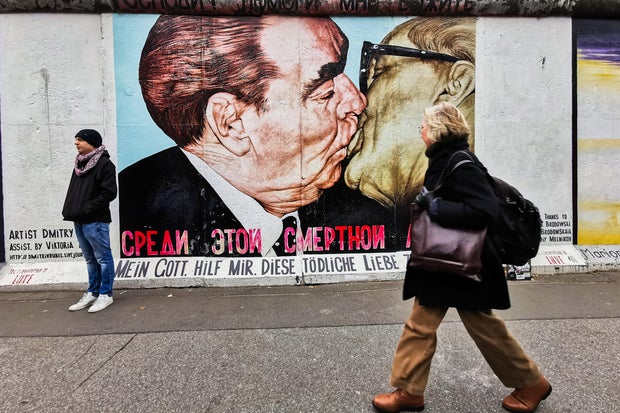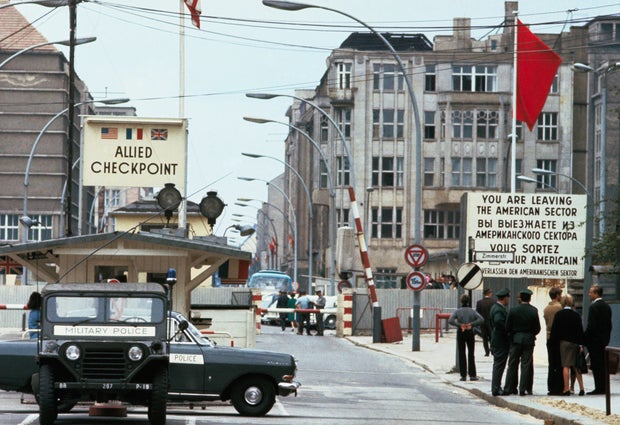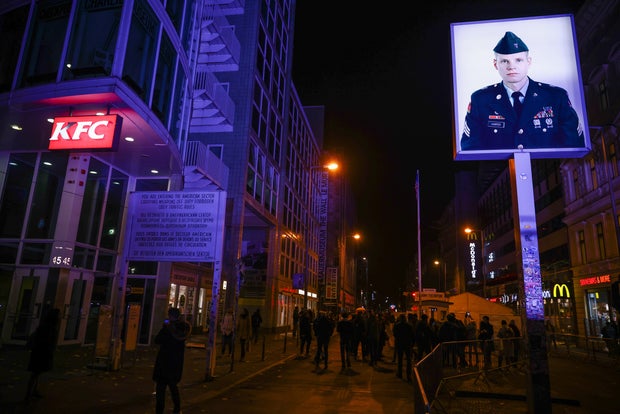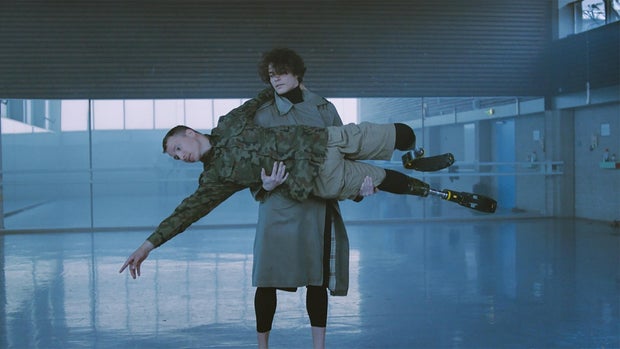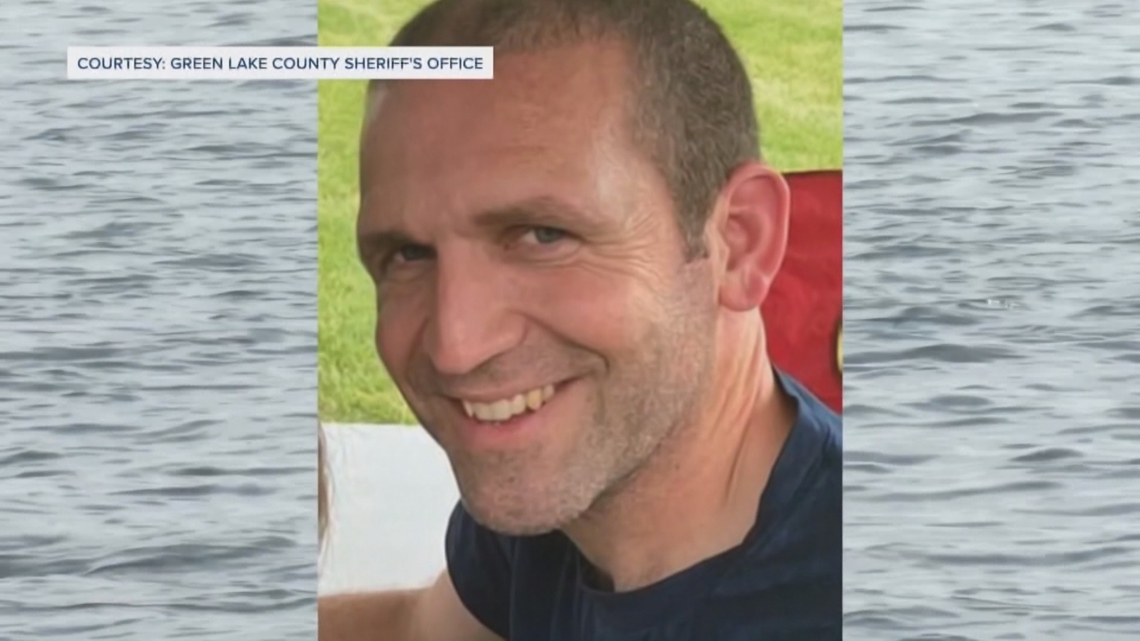CBS News
The Berlin Wall came down 35 years ago today. Fragments of the famous border still remain today.

Communist East Germany closed its border in Berlin on Aug. 13, 1961, when it erected a wall that eventually turned into an increasingly elaborate fortification snaking through the city and around capitalist West Berlin.
The heavily fortified border —the Berlin Wall— plugged the last gap between East and West.
On Nov. 9, 1989, the border was opened, and the Berlin Wall ceremoniously came down as the world watched. It marked the beginning of the end of the Cold War and the fall of the Communist dictatorship in East Germany, paving the way for German reunification in 1990 and the collapse of the Soviet Union in 1991.
Most of the wall was torn down quickly after, but 35 years later, there are still places where visitors can see its remains.
What was the Berlin Wall?
The Berlin Wall was built in 1961 and for 28 years, it stood as the front line of the Cold War between the Western world order, led by the U.S., and the Soviets.
East Germany’s leadership had already sealed off the country’s main border with West Germany, which snaked from the Baltic Sea to Czechoslovakia, in 1952.
Keystone-France/Gamma-Keystone via Getty Images
The 96-mile-long wall was built by the communist regime to cut off East Germany from the supposed ideological contamination of the West and to stem the tide of people fleeing Germany. It cut through the middle of the city center and surrounded West Berlin.
Alex Waidmann/ullstein bild via Getty Images
But not even barbed wire and the Wall could stop people from fleeing. The efforts to perfect the border fortifications in Berlin continued until 1989.
President John F. Kennedy’s pledge for freedom
President John F. Kennedy toured West Germany on June 26, 1963. During a speech to a crowd of about 150,000 people in West Berlin, he pledged that the United States would defend the city’s freedom.
“Freedom is indivisible, and when one man is enslaved, all are not free,” he said. “When all are free, then we can look forward to that day when this city will be joined as one, and this country and this great continent of Europe in a peaceful and hopeful globe.”
Bettmann
“When that day finally comes, as it will, the people of West Berlin can take sober satisfaction in the fact that they were in the front lines for almost two decades,” Kennedy added.
Then he closed with his now iconic phrase: “All free men, wherever they may live, are citizens of Berlin, and, therefore, as a free man, I take pride in the words, Ich bin ein Berliner.”
“Tear down this wall!”
President Ronald Reagan, commemorating the 750th anniversary of Berlin, spoke at the base of the Brandenburg Gate, near the Berlin Wall, on June 12, 1987. Due to the amplification system being used, Reagan’s words could be heard in East Berlin.
MIKE SARGENT/AFP via Getty Images
During his address, the American president made the now famous command, “Tear down this wall!,” addressing the Soviet leader Mikhail Gorbachev.
Reagan’s speech on that day is considered by many to have ushered the beginning of the end of the Cold War, which culminated with the fall of the Soviet Union.
When did the Berlin Wall fall?
In the late 1980s, the power of the Soviet Union began to waver, particularly when Gorbachev became General Secretary of the Communist Party in 1985. He abandoned the Brezhnev Doctrine, a central political principle of Soviet foreign policy that demanded limited sovereignty of the Warsaw Pact nations.
This allowed the Eastern Bloc of states to shift their own foreign policies, and on May 2, 1989, Hungary dismantled its border fence – making the first hole in the “Iron Curtain.”
GERARD MALIE/AFP via Getty Images
In East Germany, a growing protest movement and a migration wave to the West forced the dictatorship there to end in 1989. A new travel law mistakenly announced on Nov. 9, 1989, led to an onslaught of people to rush the Berlin Wall.
How did the Berlin Wall fall?
The Bornholmer Strasse crossing in Berlin was the first to open that night. Border guards, who hadn’t received orders to let anyone pass, gave way under pressure from a large crowd demanding to be let through after an off-handed announcement of new regulations by Politburo spokesperson Günter Schabowski.
Patrick PIEL/Gamma-Rapho via Getty Images
New border crossings were created, leaving behind large gaps in the Wall. Border soldiers began dismantling fences and other obstacles.
In June 1990, the systematic dismantling of the Wall began, and pieces of the concrete were sold all over the world. Some sections were placed under protection as historical monuments.
robert wallis/Corbis via Getty Images
The fall of the Berlin Wall paved the way for the unification of Germany on Oct. 3, 1990, less than a year after the border reopened. The demolition of the Wall ended in 1994.
Where can you see sections of the Wall today?
Today, there is a section of Wall slabs with photos and a series of plaques – including an alert sent by the Associated Press’ Germany service – that stands at the former Bornholmer Strasse crossing in Berlin.
Beata Zawrzel/NurPhoto via Getty Images
The longest section of Wall remaining in Berlin is in the so-called East Side Gallery, where the once-gray concrete slabs are covered with murals that were painted by 118 artists after the opening of the border.
Otherwise, the Wall has largely disappeared now and much of the former “death strip” — between the exterior wall that faced West Berlin and an interior wall that faced the East — has been built over.
Beata Zawrzel/NurPhoto via Getty Images
Among the exceptions is a strip of the former border at the Bernauer Strasse memorial site in downtown Berlin, and there are fragments dotted around elsewhere in the city and on its edges.
In most cases, the main East-West German border outside Berlin consisted of heavily fortified fences rather than walls. There were a few exceptions, however: most famously in the village of Moedlareuth, divided between Bavaria and the eastern region of Thuringia, which earned the nickname “Little Berlin.” Part of Moedlareuth’s border can still be seen today.
What is Checkpoint Charlie?
One of the most famous – and most visited crossings commemorating the Wall in Berlin – is Checkpoint Charlie.
Bettmann
The historic U.S.-controlled border crossing between the East and West stood for three decades. There, Allied guards registered members of the American, British and French forces before trips to East Berlin, and foreign tourists could find out about their stay there.
In October 1961, it famously became the scene of a tank confrontation between Americans and Soviet forces who took up position and faced each other with weapons primed.
Beata Zawrzel/NurPhoto via Getty Images
The checkpoint booth was removed on June 22, 1990, about half a year after the wall opened. The original booth is now on display in the Allied Museum in Berlin-Zehlendorf. A photo of former U.S. Army tuba player Seargent Jeff Harper is part of series of photographs hanging nearby the original location commemorating the last Allied soldiers in Berlin in 1994.
CBS News
Canadian teen in critical condition with suspected case of bird flu

A Canadian teen is hospitalized in critical condition with what is believed to be bird flu, a British Columbia health official said Tuesday.
It’s not clear how the teenager picked up the virus, which has been detected recently in wild birds and poultry in the province, said Dr. Bonnie Henry, provincial health officer. The teen is not known to have any contact with infected animals, she said.
Officials have released few details about the patient. Henry said the teen was healthy before developing symptoms more than a week ago — initially eye redness, cough and fever — and has been hospitalized with a respiratory illness since Friday in Vancouver.
Initial testing indicated the infection is from bird flu. Officials believe it is the Type A H5N1 bird flu, but are awaiting confirmation. H5N1 has been spreading widely in the U.S. among wild birds, poultry, cows and a number of other animals.
In Canada, testing has been done on about three dozen people who were in contact with the teen. None of them have evidence of infection, Henry said.
Officials are trying to figure out how the teen was infected, although Henry said that may never be determined. In British Columbia, the virus has been detected in poultry, wild birds and some small animals, mostly when birds are migrating through the area.
The Canadian case was in the Fraser Valley area in southern British Columbia.
So far this year, at least 46 people in the U.S. — mostly farmworkers — have tested positive with mostly mild symptoms.
According to the U.S. Centers for Disease Control and Prevention, 21 of those patients were in California, 11 in Washington, 10 in Colorado, two in Michigan and one each in Missouri and Texas.
The source of the disease was traced to either cattle or poultry in all but one of the U.S. cases. The source in the lone Missouri case was unknown, the CDC said.
CBS News
DOC NYC documentary film festival showcases real life on screen

DOC NYC, America’s largest documentary film festival, returns Wednesday for its 14th edition in New York City, with films available for viewing both in-person and online.
The festival showcases an international lineup of more than 200 feature-length and short films, including many world, North American and NYC premieres. Held in-person Nov. 13-21 at venues in Manhattan, the festival also streams many features online through Dec. 1. (For tickets and streaming passes click here.)
The festival also includes filmmaker Q&As, panel discussions, master classes and workshops with notable documentarians and industry insiders.
The full lineup may be viewed here.
Special events
The festival’s opening night feature is the U.S. premiere of “Blue Road: The Edna O’Brien Story,” Sinéad O’Shea’s revealing portrait of the defiant Irish novelist. O’Brien’s sexually-infused stories of women pushing against societal expectations, beginning with “The Country Girls,” raised the ire of Catholic sensibilities and censors, but won her fans for her clear-eyed depictions of youth and innocence being shattered.
Cleverly piecing together archival footage and TV appearances, recent interviews with O’Brien (who died in July at age 93), and clips from films adapted from her works, with actress Jessie Buckley voicing the novelist’s books and diaries, O’Shea gives voice to a woman, inspired by the writings of James Joyce, who sought her rightful place at the table of Irish literati. (Screens Nov. 13, online Nov. 14-Dec. 1.)
The centerpiece selection is the world premiere of “All God’s Children,” Ondi Timoner’s story of a rabbi and a pastor working to bring their Brooklyn communities together amid rising racial and religious tensions. (Screens Nov. 14, 16, online Nov. 15-Dec. 1.)
The closing night feature is the world premiere of Peter Yost and Michael Rohatyn’s “Drop Dead City: New York on the Brink in 1975,” about how Gotham cratered in the 1970s, thanks to a budget crisis, rising poverty, and a political and banking establishment that was ready to cut the city loose. Still the greatest city in the world, though! (Screens Nov. 21.)
Special presentations include: “2073,” Oscar-winner Asif Kapadia’s fictional documentary from the future about what we might expect to happen, given the way things are going now; “Architecton” examines mankind’s relationship with architecture, from ancient ruins to contemporary cityscapes; “The Ride Ahead” follows a young man with a rare neurodevelopmental disorder navigating the challenges of life; and “Thom Browne: The Man Who Tailors Dreams” profiles the iconoclastic fashion designer.
World premieres
Other notable world premieres include the Alex Gibney-produced “The Bibi Files,” Alexis Bloom’s expose into the corruption investigations involving Israeli Prime Minister Benjamin Netanyahu that led to his 2019 indictment. (An Israeli judged rejected Netanyahu’s demands that the film be blocked from public screenings. The corruption case against the prime minister is still ongoing.)
In the HBO documentary “Surveilled,” Ronan Farrow investigates companies that sell spyware and hacking tools to governments, which use them to surveille political activists, watchdogs and journalists. Farrow talks with software developers who explain why you’ll never know your phone has been compromised.
“Isla Familia” follows independent journalist Abraham Jiménez and his wife, producer Claudia Calviño, whose harassment by Cuban authorities leads to their living in exile in Spain. In “Mothers of Chibok,” families in a Nigerian village contend with the kidnapping of their daughters by Boko Haram.
Can comedy be therapeutic? “Anxiety Club” showcases comedians who channel their unease, agitation and apprehension into their acts.
The standup comic Gallagher became famous for smashing watermelons with a giant sledgehammer, and then seemed to fall off the map. Josh Forbes, a longtime fan, traces the path taken by Leo Gallagher, who was still trying to shake off the label “prop comic” in the years before his death in 2022, in the film “Gallagher.”
“Art Spiegelman: Disaster Is My Muse” follows the graphic artist and culture critic acclaimed for his Holocaust-themed “Maus,” who became a leading voice against book bans and Trumpism.
In “Front Row,” the United Ukrainian Ballet Company, engaged in an international tour as their country is gripped by war, offers comfort to a wounded Ukrainian soldier, who learns to dance with prosthetic legs. “After The Rain: Putin’s Stolen Children Come Home” examines the recovery of Ukrainian children, rescued following their abduction by Russian forces, and the healing they receive, among horses and dogs, at an animal therapy retreat.
DOC NYC
“Spacewoman” profiles astronaut Eileen Collins, the first woman to pilot and command the Space Shuttle. “Facing the Wind” follows the overwhelming difficulties faced by two women, Lida and Carla, who are each caring for spouses living with Lewy body dementia. Director Justin Schein takes a personal view of his father, Harvey Schein, a record company CEPO with an obsession about the estate tax, in “Death & Taxes.”
During World War II, Bruno Lohse, Hermann Göring’s art agent in Paris, facilitated the theft of masterpieces owned by French and Dutch families. But the end of the war didn’t end his work in the international art market. “Plunderer” looks at how he got away with stealing for the Nazis.
In “Yalla Parkour,” filmmaker Areeb Zuaiter takes a unique perspective among the ruins of Gaza, through the athleticism of parkour.
“Looking for Simone” explores the ramifications on feminism from the publication, in 1949, of Simone de Beauvoir’s “The Second Sex,” and the journey she took across America during the research of her manifesto.
“Nature of the Crime” follows three incarcerated men facing the bureaucracy of the parole process.
Satish Bhaskar, the “Turtle Walker” of the title, traces the Indian coastline to document the nesting areas of endangered sea turtles, and the threats to their survival.
In “Unearth,” local and Indigenous residents of the Bristol Bay area of Alaska fight the proposed development of mining near their homes.
Stories of resilience
Natalia Zubkova, a citizen journalist and mother in Russia, fields threats and harassment as she investigates corruption involving Russian authorities and the coal industry, in “Black Snow.” “Afterwar” is a coming-of-age story of children who grew up in war-torn Kosovo.
In “My Sweet Land,” director Sareen Hairabedian follows 11-year-old Vrej, an Armenian boy, whose family and village are disrupted when the neighboring country of Azerbaijan invades. Women in the Republic of Artsakh fight for their land in “There Was, There Was Not.” In “Forest,” a Polish family living an idyllic life in a remote cabin is confronted with the political implications of Europe’s migrant crisis.
“Sudan, Remember Us” follows young activists during the Sudanese revolution. In “All The Mountains Give,” two Kurdish men smuggle goods across the Iran-Iraq border. In “Flavors of Iraq,” French-born journalist Feurat Alani uses animation to tell the story of his complicated connection to his parents’ homeland.
The debilitating effects of PTSD on Navy SEAL veterans, and an experimental, hallucinogenic drug treatment, is examined in “In Waves and War.” Actors from Haiti and the Dominican Republic recreate the traumas of a 1930s genocide in “Twice Into Oblivion.”
Music
Profiles of musicians include documentaries about the rock group Steppenwolf (“Born to be Wild: The Story of Steppenwolf”); the absurdist counterculture band “Devo”; The Black Keys (“This Is A Film About The Black Keys.”); keyboardist and songwriter Billy Preston (“Billy Preston: That’s The Way God Planned It”); songwriter Diane Warren (“Diane Warren: Relentless”); trans singer Jackie Shayne (“Any Other Way: The Jackie Shane Story”); punker Harley Flanagan (“Harley Flanagan: Wired for Chaos”); singer-songwriter Janis Ian (“Janis Ian: Breaking Silence”); and the world of Steely Dan, Toto and Christopher Cross (“Yacht Rock: A Dockumentary”). And then, there is “Disco’s Revenge,” which traces the fall of the ’70s dance beat and its rebirth as house music.
Sports and Endurance
“Southpaw: The Life and Legacy of Jim Abbott” looks at the remarkable life and career of the New York Yankee pitcher born without a right hand. “Moses – 13 Steps” tracks how Olympian Edwin Moses used physics to triumph in the 400-meter hurdles.
Based on the New York Times bestseller, “76 Days Adrift” tells the story of Steve Callahan, who was stranded on a life raft in the Atlantic Ocean for nearly three months after his sailboat met with disaster. Aerial cinematographer and skydiver Joe Jennings is the subject of “Space Cowboy,” in which he attempts to film a car loaded with passengers as it hurtles towards the ground.
Profiles
“Beyond The Gaze: Jule Campbell’s Swimsuit Issue” explores the history of Sports Illustrated’s annual Swimsuit Issue and the editor behind it. The Iranian singer and actress Googoosh, whose career was stifled when she was placed under house arrest, made a comeback internationally, and now speaks out against the regime in Tehran, in “Googoosh – Made Of Fire.”
The fashion designer’s business success and activism are explored in “A Man With Sole: The Impact of Kenneth Cole.” “Man From Pretentia” profiles Paul Bridgewater, a gay NYC art dealer with an impeccable eye and a less-impeccable grasp of money.
“Petra Kelly – Act Now!” tells the story of the co-founder of German Green Party. “Shaking It Up: The Life and Times of Liz Carpenter” is a portrait of the journalist, activist and White House advisor.
“We All Bleed Red” examines the relationship New York photographer Martin Schoeller has with his subjects, from celebrities to those living on the margins. “What’s Next?” is the question posed to Dr. Howard Tucker, who at the age of 100 is recognized by Guinness World Records as the oldest practicing doctor.
Georgina, a transgender woman in her early seventies and a member of the indigenous Wayúu tribe, travels across the Colombian desert to the family that rejected her, in “Soul of the Desert.” Filmmaker Rachel Elizabeth Seed delves into the archives of her late mother, journalist Sheila Turner Seed, to reconnect with her, and her legacy, in “A Photographic Memory.”
Other festival entries
A blind Anglican priest, after living without sight for nearly four decades, becomes one of the first people to receive an experimental bionic eye implant, in “Light Darkness Light.” In the wake of the Black Lives Matter movement, three Minneapolis women work to continue fighting injustice in “The People’s Way.” During COVID, millions of Indian farmers protested exploitative farm laws by marching to New Delhi, in “Farming the Revolution.”
Eddie Huang takes an irreverent tour of the rise and fall of the Vice media empire, which he watched fall into bankruptcy, in “Vice Is Broke.” “Balomania” enters the Brazil’s favelas to explore the world of baloeiros (men who create and compete with hot air balloons), a sub-sculture that doesn’t let its illegality get in the way. A group of Rhode Island artists who lost their living space to the developers of a shopping mall takes action by creating an illicit living space within the mall. Their secret, four-year residency is documented in “Secret Mall Apartment.”
Following a month-long ordeal when their village was occupied by Russian forces, the residents of Yahidne, in northern Ukraine, try to come to grips with a less-than-normal life in “The Basement.” “The Sing Sing Chronicles” goes inside the New York correctional facility.
Michael Premo’s “Homegrown” follows three Trump supporters who zealously join the January 6th attack on the U.S. Capitol. A monument to the values of the Confederacy – a giant stone carving of Jefferson Davis, Robert E. Lee and Stonewall Jackson – looms over Stone Mountain, Georgia, and over America’s current conversation about race and history, in “Stone Mountain.”
Parents of children with dyslexia, finding little support in New York City public schools, create the Literacy Academy Collective to help further their children’s education, in “Left Behind.” The war between renters and landlords/developers, with the outcome of unsafe housing and gentrification, is documented in “Slumlord Millionaire.”
Two aging artists — photographer Joel Meyerowitz and artist-writer Maggie Barrett — try to enact the lessons learned from previous relationships as they face the last chapter of their lives, together, in “Two Strangers Trying Not to Kill Each Other.”
“G – 21 Scenes From Gottsunda” tells the stories of immigrant families in a suburb of Uppsala, Sweden, a community that has suffered from drugs and gang activity. In “Roleplay,” college students create a play based on their campus experiences involving sexual identity and power.
The Negev Desert in Israel was used as a location for the 1988 Sylvester Stallone action film “Rambo III.” Daniel Mann looks at the desert’s importance over time as the tribal home of Bedouin, in “Under A Blue Sun.” “Welcome Interplanetary and Sidereal Space Conquerors” recounts the unique role that Colombia played for NASA during the Cold War Space Race.
“The White House Effect” looks back at how past administrations, from those of Jimmy Carter to Ronald Reagan and George H.W. Bush, responded to the growing climate crisis. In “The Battle for Laikipia,” Kenyan nomads and ranchers are both devasted by drought, stirring tensions that have existed for generations.
Years after having given up their baby for adoption, a Korean couple tracks down the young woman, raised in the Netherlands, in “Between Goodbyes.” Poet Stacyann Chin struggles with the fallout of being abandoned by her mother as a baby, while raising her own child in New York City, in “A Mother Apart,”
The son of a 60-year-old Chilean gold miner creates a machine to spare his father from the toil of labor in “The Fabulous Gold Harvesting Machine”
A Chinese woman, upon discovering her husband is having an affair, hires an agency to rescue her marriage in “Mistress Dispeller” “Bad Reputation” follows a Uruguayan activist fighting to establish a union for current and former sex workers.
Armed with 8mm archival footage, filmmaker Farahnaz Sharifi creates an alternative reality for life lived under the oppressive government of Tehran, magnifying how Iran’s Islamic Revolution affected the public and private lives of women, in “My Stolen Planet.” Native Hawaiian mothers and daughters fight to stop construction of a massive telescope on the sacred slopes of Mauna Kea in “Standing Above the Clouds”
Dancer-choreographer Hadar Ahuvia explores the Palestinian-Israeli relationship through dance in “Everything You Have Is Yours.”
Los Angeles Times journalist Rosanna Xia investigates the dumping of half a million barrels of DDT waste in the ocean in “Out Of Plain Sight.”
Also showing are episodes of the limited series “Conbody vs Everybody,” from director Debra Granik (“Leave No Trace”), and “Eyes on the Prize III: We Who Believe in Freedom Cannot Rest.”
The festival also showcases recent acclaimed documentaries from Sundance, Tribeca and other festivals, including “Black Box Diaries,” “The Remarkable Life of Ibelin,” “Dahomey,” “Soundtrack to a Coup d’Etat,” “Porcelain War,” and “Eternal You.”
There are also numerous programs of short films, available in packages.
Screenings are held at the IFC Center, SVA Theatre, and Village East by Angelika theaters.
For complete program descriptions, schedules and ticket/streaming information, visit docnyc.net.
CBS News
What is a recess appointment, the power Trump wants from the next GOP leader?

Watch CBS News
Be the first to know
Get browser notifications for breaking news, live events, and exclusive reporting.


